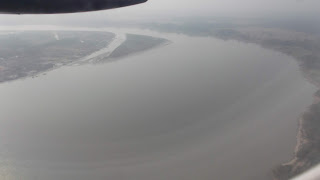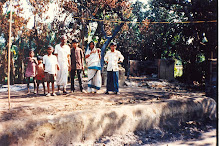The
Barisal (Barishal) Airport, Bangladesh
Dr.
Sachi G. Dastidar
ISPaD:
Partition Documentation Project Report; January 25, 2019
Barisal
(Barishal) in the coastal area of Bengal – now in Bangladesh – is located in
the world’s largest Ganga-Brahmaputra delta that has been known for millennia
as the place to be traveled only by boat, much less by air. It is a place which
is flood prone during monsoon months inundating much of the land mass. Even a
few years back road travel wasn’t easy as there were numerous river ferries
until construction of many bridges over these rivers was completed. I still
remember my parents telling me stories as to how my two older brothers went to
school by dinghy during monsoon months while walking during dry months. That
has been true for the southern districts of Bengal – Bangladesh and Paschim
Bangla (West Bengal) State of India for eternity. A 2018 trip to Venice, Italy
reminded me of my older brothers again and again as kids there were taking
ferries to go to school.
Not
far from the airport my ancestors lived for about 500 years ago establishing a
village on the land that rose from the riverbed, relocating from Gava where
written goes back another half-a-millennia, a few kilometers away but took more
than half-a-day by boat in the old days. I guess that is when my ancestors established
the village who were honored by calling one “Dastidar” by non-native,
non-Bengali-speaking Muslim rulers of Bengal who then depended on Hindus for their
day-to-day work, administration and for technical support.
Going
to Barisal by air was unthinkable until I vaguely remember my older brother, A.
G. Dastidar, a noted Soil Mechanics and Foundation Engineer with offices in
Calcutta (Kolkata) and elsewhere in India, was invited by one Mr. Islam who had
a huge construction company in Bangladesh for feasibility work for many
infrastructure and building construction projects in late 1980s through late
1990s, including an airport in Barisal. Our family is one of the indigenous
families of Barisal with a written history for almost a millennium. (I guess
writing something down was not a big thing before that.) So I thought my
ancestors must be very happy as well as perplexed by my travel plan, that was
worked by our nephew in Dhaka and a Hindu monk from the neighboring Madaripur
district, where my maternal grandparents’ ancestral home is. I was joined by my oldest sister Didi and her close friend NamitaDi. And this was by US-Bangla Airlines that was started by someone I knew from New York
City! The flight from Dhaka to Barisal was uneventful except for my oldest
sister Didi and me. For no reason we were given a special ride in the airlines' special car from the terminal to the aircraft. At the flight selfie was a must! On this flight there were many
important individuals, including the newly elected Member of Parliament of
Bangladesh from Barisal, thus there were many slogans of Joi Bangla (Victory to
Bangladesh) and Swagatam (Welcome) to
the M.P. at the Barisal terminal building. All the travelers were happy to be welcomed.
As we walked from the aircraft to the small terminal building, the atmosphere
was quite relaxed as the local security didn’t mind deplaning passengers taking
pictures of the airport building from the tarmac before entering the structure.
(In many countries one is not allowed to do that.) It didn’t take long for Mr. Alam,
the cab driver, and monk Jiban Maharaj to spot our party of 3 persons, with two
women. “Welcome to Barisal,” said both the waiting hosts. Taxis, especially
three-wheeler “auto taxis” were available in plenty. After our picture taking,
we all left for our journey that will take us to Sugandha Kali Pith Temple –
one of 51 pithas of the Black Mother Goddess Kali, followed by a stop at
Mahilara to look at the Nihar Kana Building that we had built in memory of my
mother and mother-in-law, finally to the monk’s Pranab Ashram where many
Probini-supporters built a boys’ hostel (dorm). As soon as we left the airport
parking lot we were deep in the midst of rural Bengal – green, soothing,
calming and enchanting.
May
we wish the Airport a great prosperity!
Location of Barisal District in the Costal South
View on a Foggy Day
Selfie from the Tarmac
Before Reaching the Terminal
Flight Schedule to Barisal Welcoming all Travelers
Welcome by Monk Jiban Maharaj to Didi and NamitaDi
Welcoming Visitors
Auto-Taxis at the Airport
Welcome by Mr. Alam and Rev. Maharaj
Bangladesh Countryside outside the Airport




























































